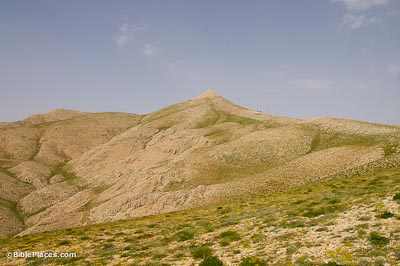Nemrut Dag is a 7,050-foot (2,150-m) tall peak located in the Anti-Taurus Mountains. Atop the mountain, King Antiochus I Theos of Commagene (69–31 BC) constructed his mausoleum. (Antiochus I Theos should not be confused with the Seleucid kings named Antiochus.) The mausoleum, which is called hierothesion in the inscriptions, consists of a 165-foot (50-m) tall conical tumulus of crushed rock with a diameter at the base of 495 feet (150 m). Terraces surround the tumulus on the east, west, and north sides. Thus far, the tomb chamber has eluded detection.
Nemrut Dag

Nemrut Dag
History of Commagene
Orondes, the Persian satrap of Commagene, assisted the Persian king Artaxerxes II (404–359 BC) in battle in 401 BC. In return, Artaxerxes II gave Orondes his daughter in marriage. Later Commagenian kings would claim Persian descent on this basis. After Alexander the Great’s death, his empire was divided among his generals, and Commagene was made a satrapy of the Seleucid kingdom with its capital at Antioch-on-the-Orontes (modern Antakya). When the Seleucids lost to Rome at the Battle of Magnesia, Samos I of Commagene declared Commagene’s independence in 163 BC. His grandson, Mithridates I Callinicus married the daughter of the Seleucid king Antiochus VIII Grypus, allowing their son Antiochus I Theos of Commagene to claim both Seleucid and Persian descent.


Colossal Statues
The east and west terraces consisted of courts. The side of the court against the tumulus was lined with colossal limestone seated statues 23–26 feet (7–8 m) tall. The colossal statues represent Antiochus I Theos, the personification of the kingdom of Commagene, Zeus-Oromasdes, Apollo-Mithras, and Heracles-Artagnes-Ares. The compound deity names reflect the Persian, Greek, and Roman influence on the cultural and religious history of Commagene.
Greek Inscription
The backs of the colossal statues contain a Greek inscription with genealogies, dedications, and instructions for cult celebration and maintenance. Nemrut Dag was discovered by Karl Sester in 1881. From 1953 to 1956, Theresa B. Goell conducted excavations on behalf of the American Schools of Oriental Research. In 1984, restoration work was begun by Friedrich Karl Dörner, and since 1989 has continued under Sencer Şahin.


Download all of our Eastern Turkey photos!
$34.00 $49.99 FREE SHIPPING
Related Websites
See also Ararat-Urartu, Carchemish, Haran, Hattusha, and Karatepe.
Nemrud Daği (Livius) Provides captioned photos from the site.
Nemrut Dagi (Sacred Sites) Provides a description of the site and its remains.
Nemrud Dagi, Turkey (Learning Sites) This page features a digital reconstruction of the site.
Mount Nemrut (Wikipedia) Encyclopedia entry on Nemrut Dag.
Mount Nemrut (Turkish Archaeological News) A long article with many photos, focusing on the site’s excavation history.
Nemrut Mountain pictures – Turkey (personal website) Gallery of photographs of Nemrut Dag.
How to Visit Mount Nemrut (The Mediterranean Traveller) Features several nice photographs as well as updated travel information.